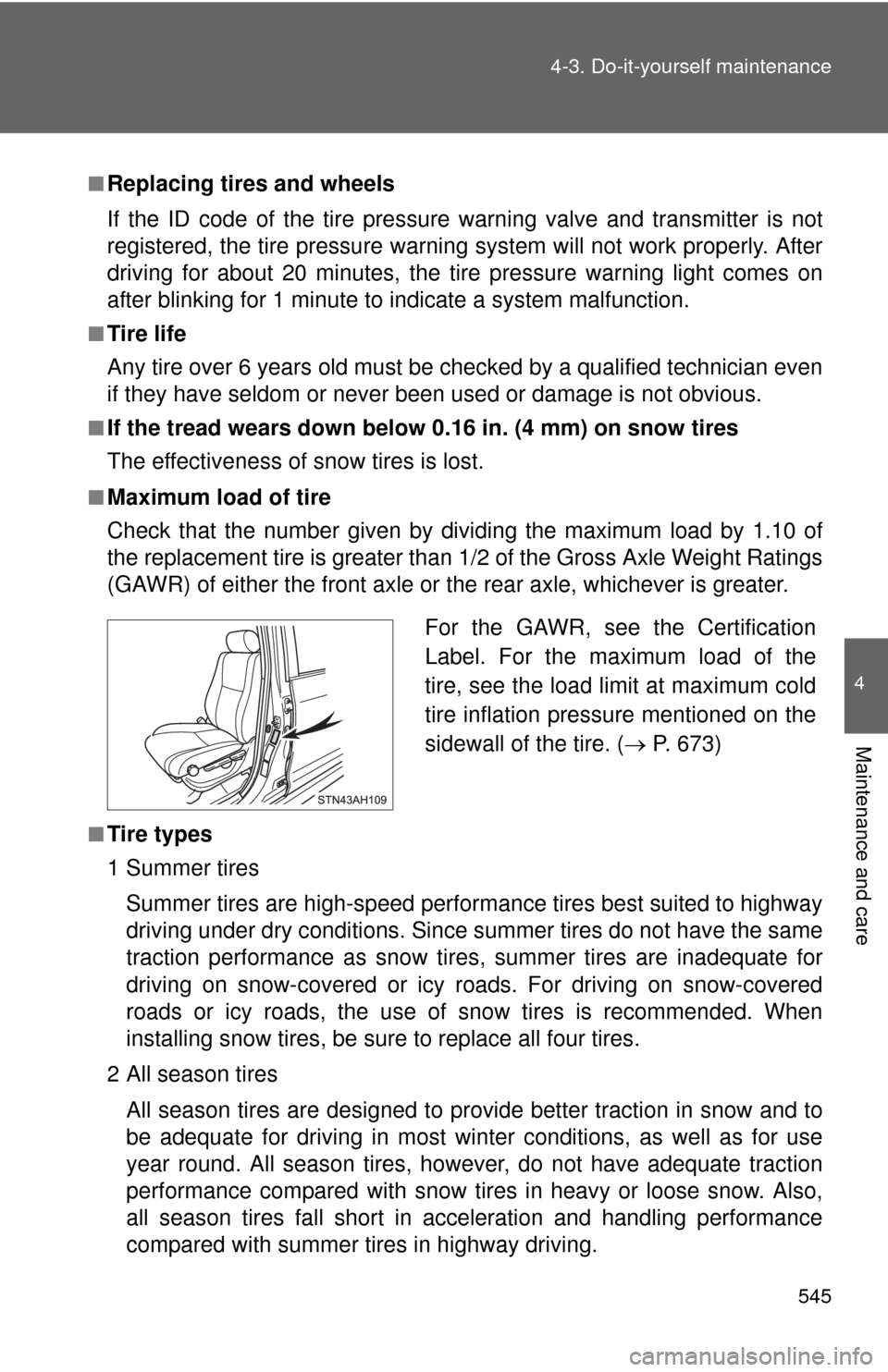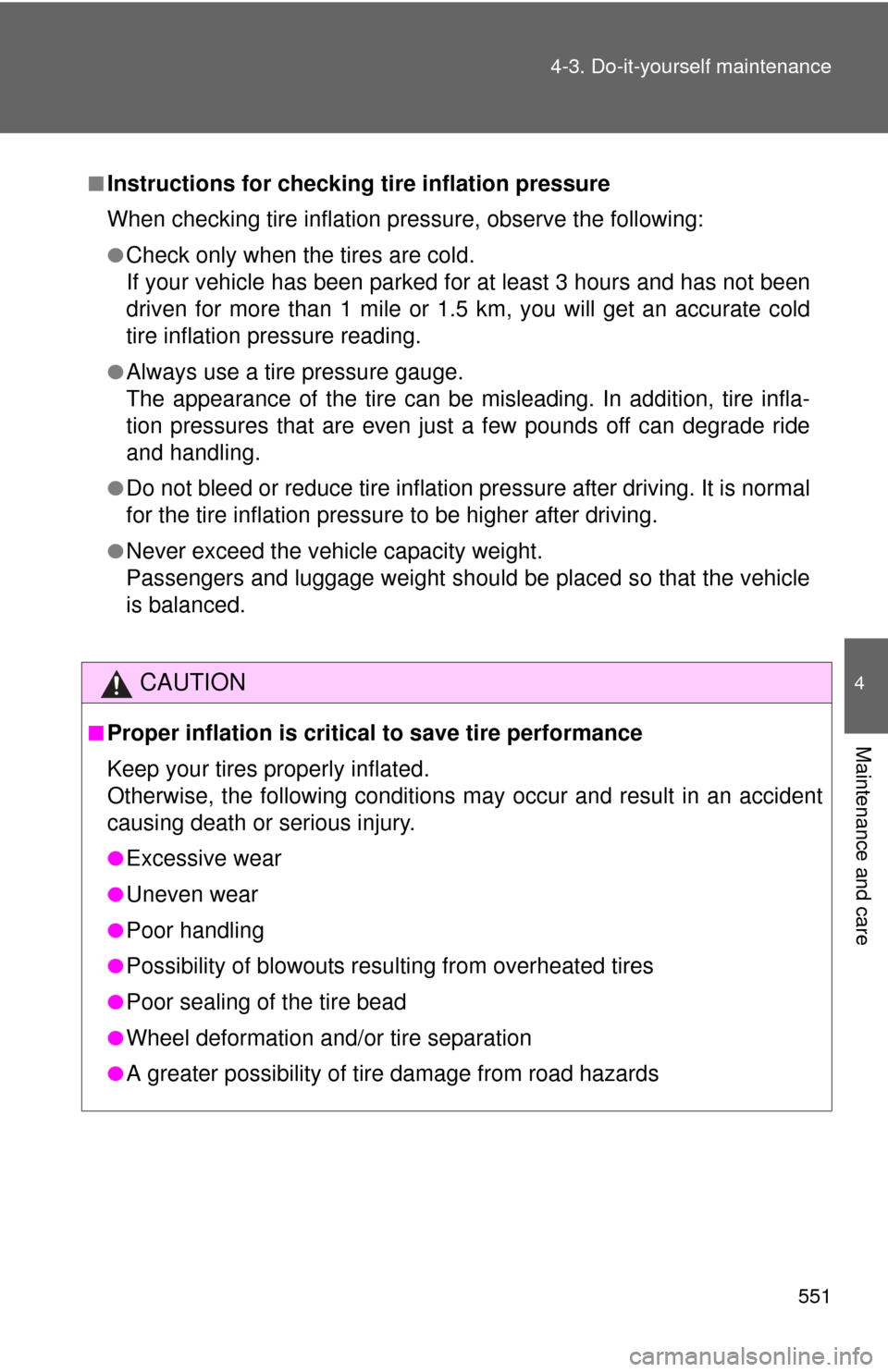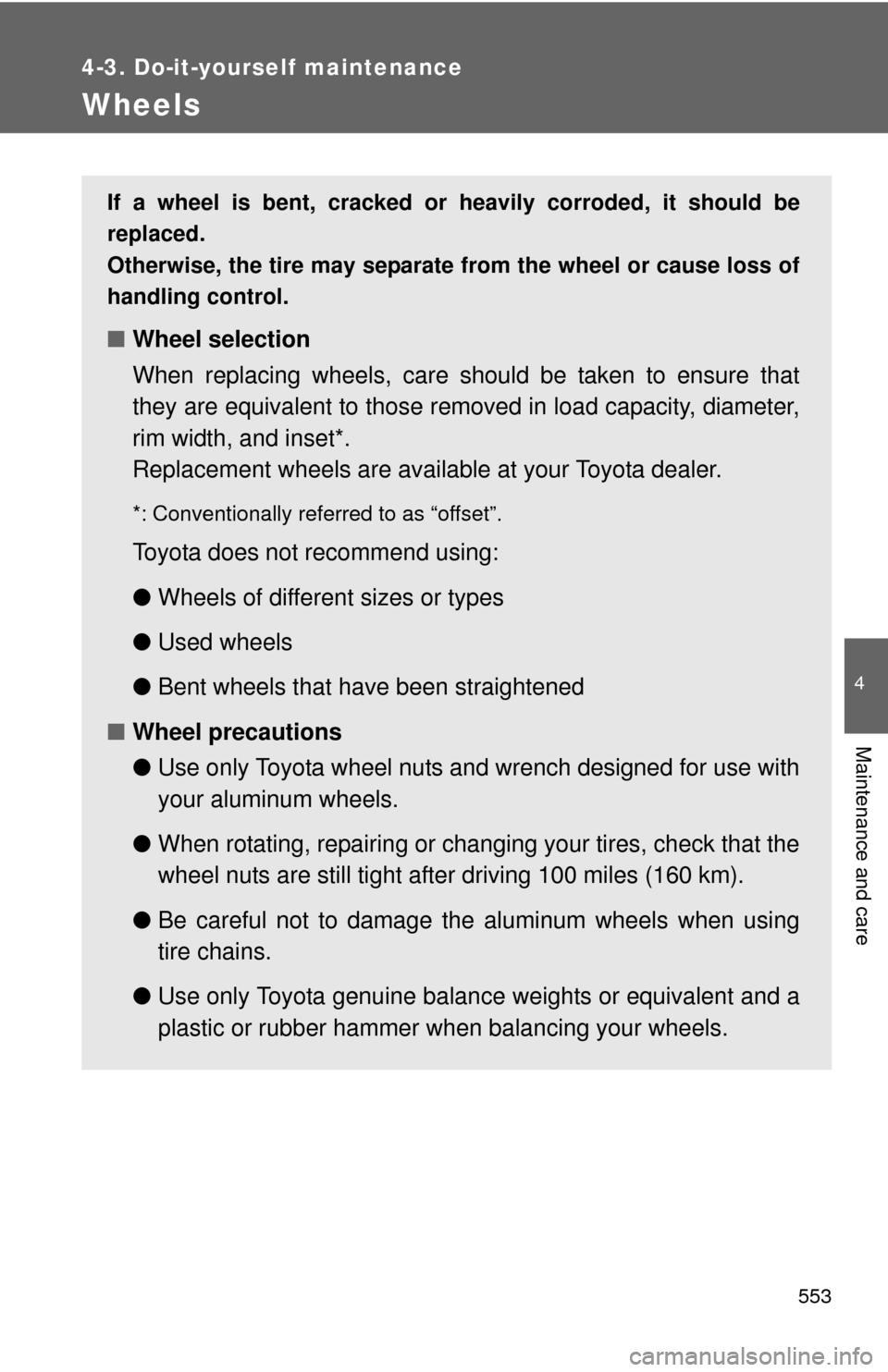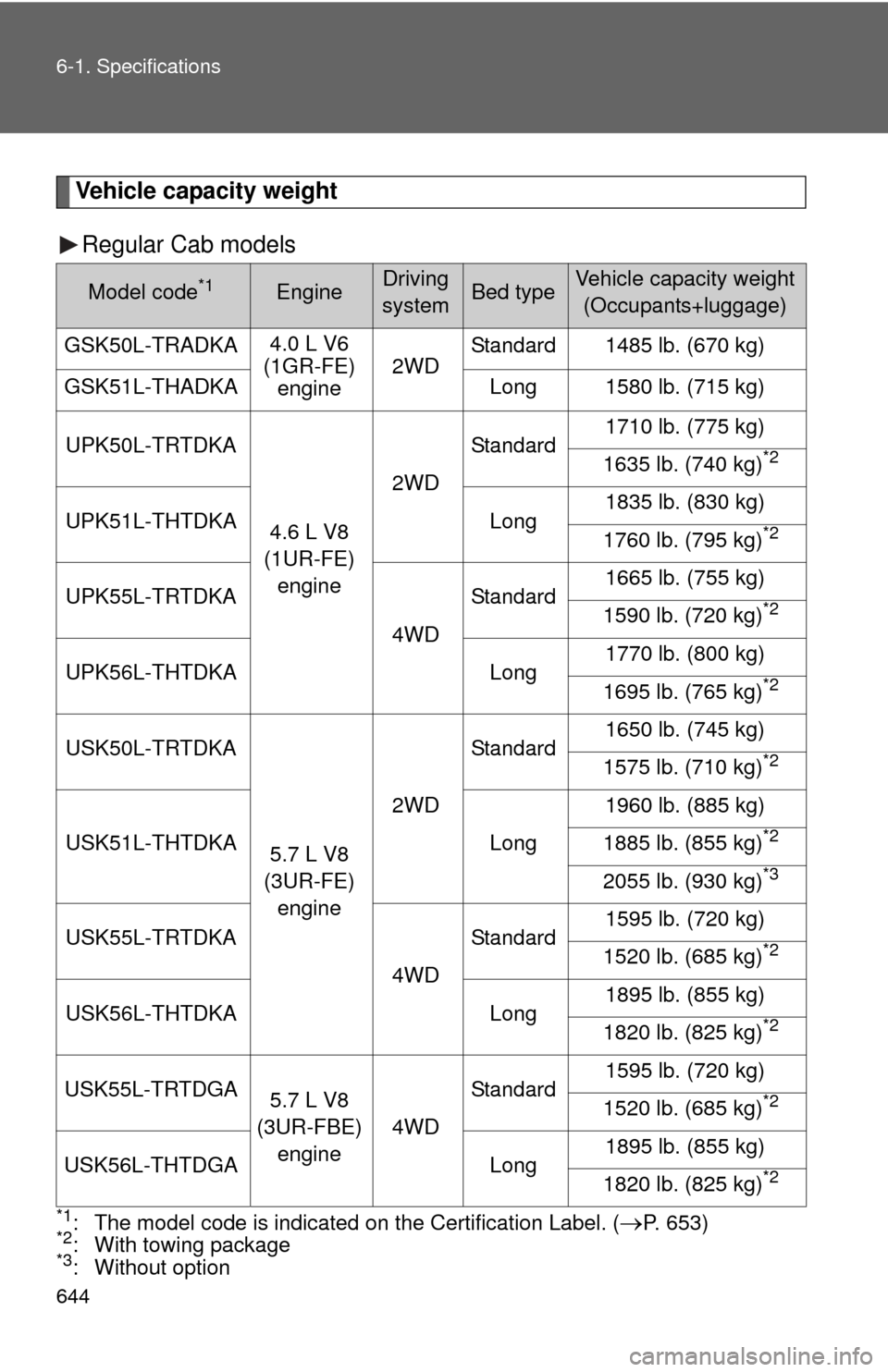Page 545 of 724

545
4-3. Do-it-yourself maintenance
4
Maintenance and care
■Replacing tires and wheels
If the ID code of the tire pressure warning valve and transmitter is not
registered, the tire pre
ssure warning system will not work properly. After
driving for about 20 minutes, the ti re pressure warning light comes on
after blinking for 1 minute to indicate a system malfunction.
■Tire life
Any tire over 6 years old must be checked by a qualified technician even
if they have seldom or never been used or damage is not obvious.
■If the tread wears down below 0.16 in. (4 mm) on snow tires
The effectiveness of snow tires is lost.
■Maximum load of tire
Check that the number given by divi ding the maximum load by 1.10 of
the replacement tire is greater than 1/2 of the Gross Axle Weight Ratings
(GAWR) of either the front axle or the rear axle, whichever is greater.
■Tire types
1 Summer tires
Summer tires are high-speed performance tires best suited to highway
driving under dry conditions. Since summer tires do not have the same
traction performance as snow tire s, summer tires are inadequate for
driving on snow-covered or icy roads. For driving on snow-covered
roads or icy roads, the use of snow tires is recommended. When
installing snow tires, be sure to replace all four tires.
2 All season tires All season tires are designed to provide better traction in snow and to
be adequate for driving in most winter conditions, as well as for use
year round. All season tires, however, do not have adequate traction
performance compared with snow tires in heavy or loose snow. Also,
all season tires fall short in acceleration and handling performance
compared with summer tires in highway driving.
For the GAWR, see the Certification
Label. For the maximum load of the
tire, see the load limit at maximum cold
tire inflation pressure mentioned on the
sidewall of the tire. ( P. 673)
Page 551 of 724

551
4-3. Do-it-yourself maintenance
4
Maintenance and care
■Instructions for checking tire inflation pressure
When checking tire inflation pressure, observe the following:
●Check only when the tires are cold.
If your vehicle has been parked for at least 3 hours and has not been
driven for more than 1 mile or
1.5 km, you will get an accurate cold
tire inflation pressure reading.
●Always use a tire pressure gauge.
The appearance of the tire can be mi sleading. In addition, tire infla-
tion pressures that are even just a few pounds off can degrade ride
and handling.
●Do not bleed or reduce tire inflation pressure after driving. It is normal
for the tire inflation pressure to be higher after driving.
●Never exceed the vehicle capacity weight.
Passengers and luggage weight should be placed so that the vehicle
is balanced.
CAUTION
■Proper inflation is critical to save tire performance
Keep your tires properly inflated.
Otherwise, the following conditions may occur and result in an accident
causing death or serious injury.
●Excessive wear
●Uneven wear
●Poor handling
●Possibility of blowouts resu lting from overheated tires
●Poor sealing of the tire bead
●Wheel deformation and/or tire separation
●A greater possibility of tire damage from road hazards
Page 553 of 724

553
4-3. Do-it-yourself maintenance
4
Maintenance and care
Wheels
If a wheel is bent, cracked or heavily corroded, it should be
replaced.
Otherwise, the tire may separate from the wheel or cause loss of
handling control.
■Wheel selection
When replacing wheels, care should be taken to ensure that
they are equivalent to those removed in load capacity, diameter,
rim width, and inset*.
Replacement wheels are available at your Toyota dealer.
*: Conventionally referred to as “offset”.
Toyota does not recommend using:
●Wheels of different sizes or types
● Used wheels
● Bent wheels that have been straightened
■ Wheel precautions
●Use only Toyota wheel nuts and wrench designed for use with
your aluminum wheels.
● When rotating, repairing or changing your tires, check that the
wheel nuts are still tight after driving 100 miles (160 km).
● Be careful not to damage the aluminum wheels when using
tire chains.
● Use only Toyota genuine balance weights or equivalent and a
plastic or rubber hammer when balancing your wheels.
Page 600 of 724

600 5-2. Steps to take in an emergency
The light will go off after taking several driving trips.
If the light does not go off even after several trips, contact your Toyota dealer
as soon as possible.
■ Front passenger detect ion sensor and passenger seat belt reminder
If luggage or other load is placed on the right front passenger seat, depend-
ing on its weight, the reminder light to flash and buzzer to sound.
■
When the tire pressure warning light comes on
Check the tire inflation pressure and adjust to the appropriate level.
Pushing the tire pressure warning reset switch does not turn off the tire
pressure warning light.
■The tire pressure warning light ma y turn on due to natural causes
The tire pressure warning light may turn on due to natural causes such
as natural air leaks or tire inflation pressure changes caused by temper-
ature. In this case, adjusting the ti re inflation pressure will turn off the
warning light (after several minutes).
■When a tire is replaced with a spare tire
The temporary spare tire is not equipped with the tire pressure warning
valve and transmitter. If a tire goes flat, the tire pressure warning light will
not turn off even though the flat tire is replaced with the temporary spare
tire. Replace the temporary spare tire with the repaired tire and adjust
the proper tire inflatio n pressure. The tire pres sure warning light will turn
off after several minutes.
■If the tire pressure warning system is inoperative
The tire pressure warning system will be disabled in the following condi-
tions:
(When the condition becomes normal, the system will work properly.)
●If tires not equipped with tire pressure warning valves and transmit-
ters are used.
●If the ID code on the tire pressure warning valves and transmitters is
not registered in the tire pressure warning computer.
The tire pressure warning system may be disabled in the following condi-
tions:
(When the condition becomes normal, the system will work properly.)
●If electronic devices or facilities using similar radio wave frequencies
are nearby.
Page 644 of 724

644 6-1. Specifications
Vehicle capacity weightRegular Cab models
*1: The model code is indicated on the Certification Label. (P. 653)*2: With towing package*3: Without option
Model code*1EngineDriving
systemBed typeVehicle capacity weight (Occupants+luggage)
GSK50L-TRADKA 4.0 L V6
(1GR-FE) engine 2WD
Standard 1485 lb. (670 kg)
GSK51L-THADKA Long 1580 lb. (715 kg)
UPK50L-TRTDKA
4.6 L V8
(1UR-FE) engine 2WD
Standard
1710 lb. (775 kg)
1635 lb. (740 kg)
*2
UPK51L-THTDKA Long1835 lb. (830 kg)
1760 lb. (795 kg)*2
UPK55L-TRTDKA 4WDStandard
1665 lb. (755 kg)
1590 lb. (720 kg)*2
UPK56L-THTDKA Long1770 lb. (800 kg)
1695 lb. (765 kg)*2
USK50L-TRTDKA
5.7 L V8
(3UR-FE) engine 2WD
Standard
1650 lb. (745 kg)
1575 lb. (710 kg)*2
USK51L-THTDKA Long1960 lb. (885 kg)
1885 lb. (855 kg)*2
2055 lb. (930 kg)*3
USK55L-TRTDKA 4WDStandard
1595 lb. (720 kg)
1520 lb. (685 kg)*2
USK56L-THTDKA Long1895 lb. (855 kg)
1820 lb. (825 kg)*2
USK55L-TRTDGA 5.7 L V8
(3UR-FBE) engine 4WDStandard
1595 lb. (720 kg)
1520 lb. (685 kg)*2
USK56L-THTDGA Long1895 lb. (855 kg)
1820 lb. (825 kg)*2
Page 645 of 724
645
6-1. Specifications
6
Vehicle specifications
Double Cab models
Model code*1EngineDriving
systemBed typeVehicle capacity weight (Occupants+luggage)
GSK51L-CRASKA 4.0 L V6
(1GR-FE) engine 2WD
Standard1290 lb. (585 kg)
UPK51L-CRTSKA
4.6 L V8
(1UR-FE) engine 2WD
Standard
1410 lb. (635 kg)
1335 lb. (605 kg)
*2
UPK51L-CRTLKA 1440 lb. (650 kg)
1365 lb. (615 kg)*2
UPK52L-CHTSKALong 1325 lb. (600 kg)*2
UPK56L-CRTSKA
4WD
Standard
1330 lb. (600 kg)
1255 lb. (565 kg)
*2
UPK56L-CRTLKA 1360 lb. (615 kg)
1285 lb. (580 kg)*2
UPK57L-CHTSKALong 1235 lb. (560 kg)*2
USK51L-CRTSKA
5.7 L V8
(3UR-FE) engine 2WD
Standard
1540 lb. (695 kg)
1465 lb. (660 kg)
*2
USK51L-CRTLKA 1570 lb. (710 kg)
1495 lb. (675 kg)*2
USK52L-CHTSKALong 1455 lb. (655 kg)*2
USK56L-CRTSKA
4WD
Standard
1455 lb. (655 kg)
1380 lb. (625 kg)
*2
USK56L-CRTLKA 1485 lb. (670 kg)
1410 lb. (635 kg)*2
USK57L-CHTSKALong 1360 lb. (615 kg)*2
Page 646 of 724
646 6-1. Specifications
*1: The model code is indicated on the Certification Label. (P. 653)*2: With towing packageCrewMax models
Model code*1EngineDriving
systemBed typeVehicle capacity weight (Occupants+luggage)
USK56L-CRTSGA 5.7 L V8
(3UR-FBE) engine 4WD
Standard 1455 lb. (655 kg)
1380 lb. (625 kg)
*2
USK56L-CRTLGA 1485 lb. (670 kg)
1410 lb. (635 kg)*2
USK57L-CHTSGA Long 1360 lb. (615 kg)*2
Model code*1EngineDriving
systemBed typeVehicle capacity weight (Occupants+luggage)
UPK51L-PSTSKA
4.6 L V8
(1UR-FE) engine 2WD
Short 1330 lb. (600 kg)
1255 lb. (565 kg)
*2
1220 lb. (550 kg)*3
UPK51L-PSTLKA 1360 lb. (615 kg)
1285 lb. (580 kg)*2
1250 lb. (565 kg)*3
UPK56L-PSTSKA
4WD1250 lb. (565 kg)
1175 lb. (530 kg)*2
1140 lb. (515 kg)*3
UPK56L-PSTLKA 1265 lb. (570 kg)
1190 lb. (535 kg)*2
1155 lb. (520 kg)*3
Page 647 of 724
647
6-1. Specifications
6
Vehicle specifications
*1: The model code is indicated on the Certification Label. (P. 653)*2: With towing package or electric moon roof*3: With towing package and electric moon roof
Model code*1EngineDriving
systemBed typeVehicle capacity weight (Occupants+luggage)
USK51L-PSTSKA
5.7 L V8
(3UR-FE) engine 2WD
Short 1445 lb. (655 kg)
1370 lb. (620 kg)
*2
1335 lb. (605 kg)*3
USK51L-PSTLKA 1495 lb. (675 kg)
1420 lb. (640 kg)*2
1385 lb. (625 kg)*3
USK56L-PSTSKA
4WD1375 lb. (620 kg)
1300 lb. (585 kg)*2
1265 lb. (570 kg)*3
USK56L-PSTLKA 1405 lb. (635 kg)
1330 lb. (600 kg)*2
1295 lb. (585 kg)*3
USK56L-PSTSGA 5.7 L V8
(3UR-FBE) engine 4WD 1375 lb. (620 kg)
1300 lb. (585 kg)*2
1265 lb. (570 kg)*3
USK56L-PSTLGA 1405 lb. (635 kg)
1330 lb. (600 kg)*2
1295 lb. (585 kg)*3